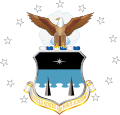| 70th Flying Training Squadron [1] | |
|---|---|
 70th Flying Training Squadron Patch | |
| Active |
15 January 1941 - 10 May 1946 25 February 1953 - 25 June 1966 1 August 1972 - 30 September 1973 1 December 1973 - 1 December 1975 22 October 2005 - present |
| Country | United States |
| Branch | United States Air Force |
| Part of |
Air Force Reserve Command 10th Air Force 340th Flying Training Group |
| Garrison/HQ | United States Air Force Academy |
| Decorations |
|
| Commanders | |
| Current commander | Lieutenant Colonel Rodriguez |

Emblem of the World War II 70th Bombardment Squadron
The 70th Flying Training Squadron (70 FTS) is Reserve unit of the United States Air Force based at the United States Air Force Academy, Colorado.
70 FTS augments the 94th Flying Training Squadron for glider training, augments the parachuting element of training for the 98th Flying Training Squadron, and supports the 557th Flying Training Squadron by assisting the cadet flying team compete at a national intercollegiate level as well as providing oversight in the Academy flight screening program.
Mission[]
The 70th supports sailplane, powered flight, Initial Flight Screening, and parachute operations at the United States Air Force Academy.
History[]
Established as a pre-World War II GHQAF bombardment squadron; equipped with B-18 Bolos and early-model B-26 Marauders. After the Japanese Attack on Pearl Harbor, squadron was engaged in antisubmarine operations over the mid-Atlantic coast. Reassigned to Third Air Force and equipped with A-26 Invader light bombers; deployed to Fifth Air Force in Australia in 1942 as part of the re-equipping of that command after its withdraw to Australia after the 1941-1942 Battle of the Philippines.
Deployed to South Pacific Area (SPA); being assigned to Thirteenth Air Force and attacking enemy targets in the Solomon Islands; New Hebrides and other enemy locations north and east of Papua New Guinea. Became part of Mac Arthur's New Guinea campaign, supported Army ground forces with tactical bombing of enemy formations and targets along the northern coast of New Guinea and in the Dutch East Indies.
Attacked enemy forces in the Philippines during early 1945 as part of the liberation from Japanese control; continued combat missions until the Japanese capitulation in August 1945. Became part of the Fifth Air Force forces in Occupied Japan in 1946 before being demobilized and inactivated in May 1946.
Reactivated as a Strategic Air Command B-36 Peacemaker bombardment squadron in 1953. Engaged in worldwide training missions with the B-36 until 1956 when re-equipped with the jet B-52 Stratofortress. Deployed to Western Pacific during the Vietnam War and flew conventional Arc Light bombardment missions over enemy military and industrial targets in North Vietnam. Inactivated in 1966 due to budget reductions.
Reactivated as an Undergraduate Pilot Training (UPT) T-37 Tweet squadron in 1972. Remained in Air Training Command providing initial flight training first at Laredo AFB, then at Moody AFB. Inactivated in 1975 when Moody was transferred to Tactical Air Command as a fighter base.
Reactivated in the Reserve at the United States Air Force Academy in 2005 as a pilot screening squadron, replacing Detachment 1, 302nd Operations Group. Also flies unpowered gliders.[2]
Lineage[]
- Constituted 70 Bombardment Squadron (Medium) on 20 November 1940
- Activated on 15 January 1941
- Redesignated 70 Bombardment Squadron, Medium, on 19 September 1944
- Inactivated on 10 May 1946
- Redesignated 70 Bombardment Squadron, Heavy, on 19 February 1953
- Activated on 25 February 1953
- Discontinued, and inactivated, on 25 June 1966
- Redesignated 70 Flying Training Squadron on 22 March 1972
- Activated on 1 August 1972. Inactivated on 30 September 1973
- Activated on 1 December 1973
- Inactivated on 1 December 1975
- Activated on 22 October 2005.
Assignments[]
- 38th Bombardment Group, 15 January 1941
- 42d Bombardment Group, 26 February 1943 – 10 May 1946
- 42d Bombardment Wing, 25 February 1953 – 25 June 1966
- 38th Flying Training Wing, 1 August 1972 – 30 September 1973; 1 December 1973 – 1 December 1975
- 302d Operations Group, 22 October 2005–present
Stations[]
|
|
Aircraft operated[]
- B-18 Bolo (1941)
- B-26 Marauder (1941–1943)
- B-25 Mitchell (1943–1945)
- B-36 Peacemaker (1953–1956)
- B-52 Stratofortress (1956–1966)
- T-37 Tweet (1972–1973, 1973–1975)
Operations[]
See also[]
References[]
This article incorporates public domain material from the Air Force Historical Research Agency website http://www.afhra.af.mil/.
- Maurer, Maurer, ed (1982) [1969]. Combat Squadrons of the Air Force, World War II (reprint ed.). Washington, DC: Office of Air Force History. ISBN 0-405-12194-6. LCCN 70605402. OCLC 72556. http://www.airforcehistory.hq.af.mil/Publications/fulltext/combat_sq_of_the_af_wwii.pdf.
Notes[]
- ↑ AFHRA 70 FTS Page
- ↑ Reserve squadron soars onto Academy flightline, 25 October 2005, by Technical Sgt. Jason Tudor, Headquarters Air Force Reserve
Bibliography[]
| |||||||||||||||||||||||||||||||||||||
| |||||||||||||||||||||||||||
| |||||||||||||||||||||||||||||||
The original article can be found at 70th Flying Training Squadron and the edit history here.


